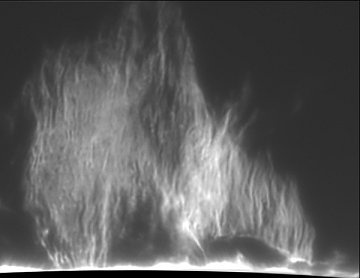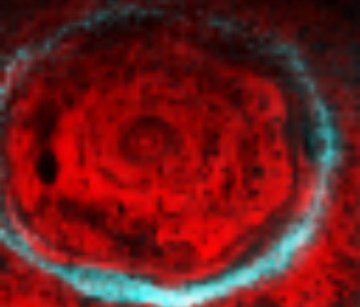 Did you miss last night's auroras? Next time get a wake-up call from Spaceweather PHONE.
Did you miss last night's auroras? Next time get a wake-up call from Spaceweather PHONE.
ASTEROID FLYBY: Asteroid 2006 VV2 is about to fly past Earth. On March 30th around 11 pm PDT the 2 km-wide space rock will streak through the constellation Leo only 2 million miles away glowing like a 9th-to-10th magnitude star. This makes it an easy target for backyard telescopes with CCD cameras. Observers in the Americas are favored. [ephemeris] [3D orbit]
SOLAR ACTIVITY: "The seeing was quite good." That's an understatement from Harald Paleske of Langendorf, Germany, who took this picture of a prominence leaping over the sun's limb yesterday:

Photo details: 225/200/2700mm Unigraph, 1/91 sec exposure
Prominences are hot clouds of hydrogen thrust up by solar magnetic force fields. This one is about four times taller than Earth and many observers say it shimmers like a candle flame. It's still there today; if you have a solar telescope, take a look.
more images: from Andreas Murner of Bavaria, Germany; from Robert Arnold of Isle of Skye, Scotland; from Adrian Guzman of San Jose, California.
BIZARRE HEXAGON: "We've never seen anything like it on any other planet," says atmospheric scientist Kevin Baines of the Jet Propulsion Laboratory. It is a hexagon twice as wide as Earth encircling Saturn's north pole. First observed by Voyager 1 in the 1980s, the hexagon has been sighted anew by the Cassini spacecraft:

In this infrared photo taken by Cassini, the blue color traces auroras at high altitudes in Saturn's atmosphere. Red indicates the amount heat filtering up through clouds below. Researchers believe the auroras and the hexagon are unrelated.
The hexagon could be a distant cousin of Earth's polar vortex, but while Earth's vortex is a circle, Saturn's may be molded into a hexagon by some strange pattern of atmospheric waves. "Saturn's thick atmosphere where circularly-shaped waves and convective cells dominate is perhaps the last place you'd expect to see such a six-sided geometric figure--yet there it is," says Baines.
UPDATE: Spaceweather reader Richard Haydon may have a solution to the mystery of the hexagon: "It's a nut!" he says. "The two hemispheres of Saturn are obviously held together by a nut and bolt. I bet the other end is circular." Indeed it is. Saturn's south pole is surrounded by a hurricane-shaped storm with a giant circular eye. Surprisingly, the hardware theory seems to hold water.

